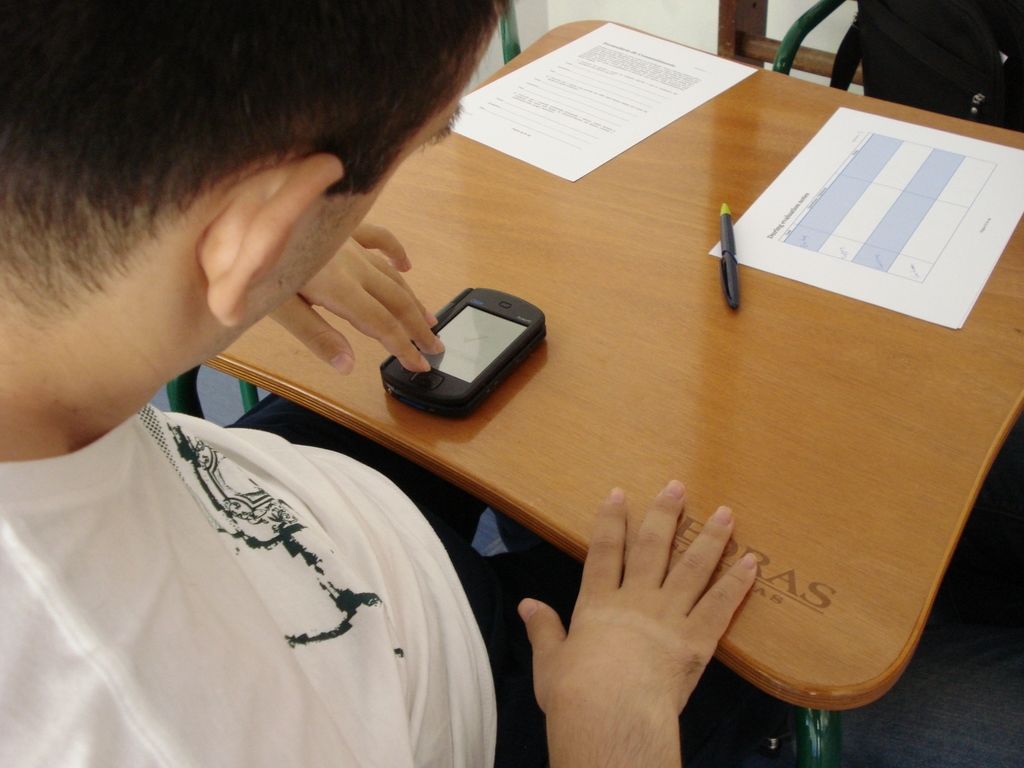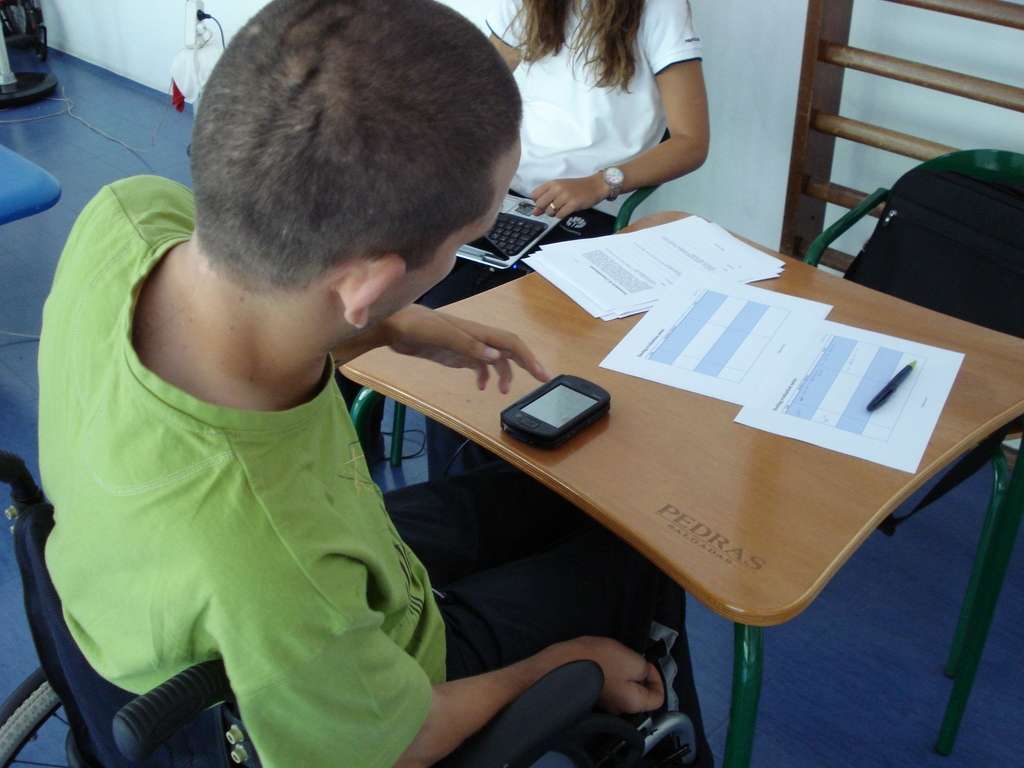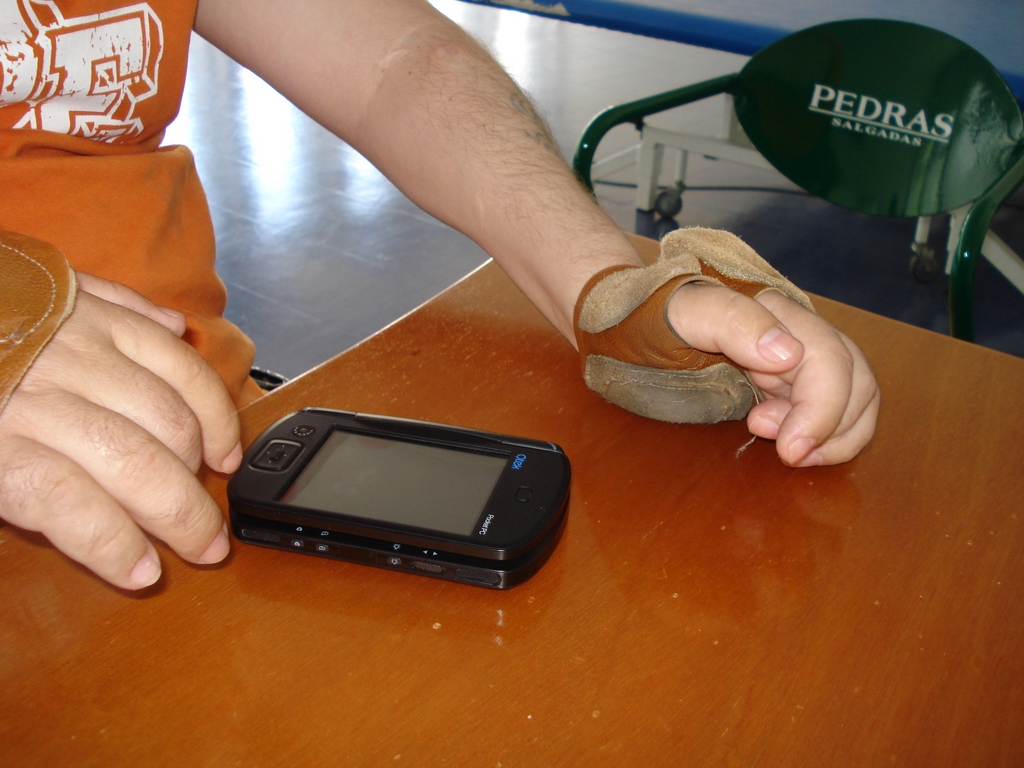Touch screen mobile devices bear the promise of endless leisure, communication, and productivity opportunities to motor-impaired people. Indeed, users with residual capacities in their upper extremities could benefit immensely from a device with no demands regarding strength. However, the precision required to effectively select a target without physical cues creates problems to people with limited motor abilities.
Our goal is to thoroughly study mobile touchscreen interfaces, their characteristics and parameterizations, thus providing the tools for informed interface design.
Project Details
Title: Motor-Impaired and Touchscreen Accessibility
Date: Jan 1, 2017
Authors: Hugo Nicolau, Tiago Guerreiro, Kyle Montague, Daniel Gonçalves, Joaquim Jorge
Keywords: motor-impaired, touchscreen, mobile, gestures, performance
Related Publications
- Motor-impaired Touchscreen Interactions in the Wild
- Kyle Montague, Hugo Nicolau, and Vicki L. Hanson. 2014. Motor-impaired Touchscreen Interactions in the Wild. Proceedings of the 16th International ACM SIGACCESS Conference on Computers & Accessibility, ACM, 123–130. http://doi.org/10.1145/2661334.2661362
- [ABSTRACT] [PDF] [LIBRARY]
Touchscreens are pervasive in mainstream technologies; they offer novel user interfaces and exciting gestural interactions. However, to interpret and distinguish between the vast ranges of gestural inputs, the devices require users to consistently perform interactions inline with the predefined location, movement and timing parameters of the gesture recognizers. For people with variable motor abilities, particularly hand tremors, performing these input gestures can be extremely challenging and impose limitations on the possible interactions the user can make with the device. In this paper, we examine touchscreen performance and interaction behaviors of motor-impaired users on mobile devices. The primary goal of this work is to measure and understand the variance of touchscreen interaction performances by people with motor-impairments. We conducted a four-week in-the-wild user study with nine participants using a mobile touchscreen device. A Sudoku stimulus application measured their interaction performance abilities during this time. Our results show that not only does interaction performance vary significantly between users, but also that an individual’s interaction abilities are significantly different between device sessions. Finally, we propose and evaluate the effect of novel tap gesture recognizers to accommodate for individual variances in touchscreen interactions.
- Mobile touchscreen user interfaces: bridging the gap between motor-impaired and able-bodied users
- Hugo Nicolau, Tiago Guerreiro, Joaquim Jorge, and Daniel Gonçalves. 2014. Mobile touchscreen user interfaces: bridging the gap between motor-impaired and able-bodied users. Universal Access in the Information Society 13, 3: 303–313. http://doi.org/doi:10.1007/s10209-013-0320-5
- [ABSTRACT] [PDF] [LIBRARY]
Touchscreen mobile devices are highly customizable, allowing designers to create inclusive user interfaces that are accessible to a broader audience. However, the knowledge to provide this new generation of user interfaces is yet to be uncovered. The goal was to thoroughly study mobile touchscreen interfaces and provide guidelines for informed design. The paper presents an evaluation performed with 15 tetraplegic and 18 able-bodied users that allowed to identify their main similarities and differences within a set of interaction techniques (Tapping, Crossing, and Directional Gesturing) and parameterizations. Results show that Tapping and Crossing are the most similar and easy to use techniques for both motor-impaired and able-bodied users. Regarding Tapping, error rates start to converge at 12 mm, showing to be a good compromise for target size. As for Crossing, it offered a similar level of accuracy; however, larger targets (17 mm) are significantly easier to cross for motor-impaired users. Directional Gesturing was the least inclusive technique. Regarding position, edges showed to be troublesome. For instance, they have shown to increase Tapping precision for disabled users, while decreasing able-bodied users’ accuracy when targets are too small (7 mm). It is argued that despite the expected error rate disparity, there are clear resemblances between user groups, thus enabling the development of inclusive touch interfaces. Tapping, a traditional interaction technique, was among the most effective for both target populations, along with Crossing. The main difference concerns Directional Gesturing that in spite of its unconstrained nature shows to be inaccurate for motor-impaired users.
- Elderly Text-entry Performance on Touchscreens
- Hugo Nicolau and Joaquim Jorge. 2012. Elderly Text-entry Performance on Touchscreens. Proceedings of the 14th International ACM SIGACCESS Conference on Computers and Accessibility, ACM, 127–134. http://doi.org/10.1145/2384916.2384939
- [ABSTRACT] [PDF] [LIBRARY]
Touchscreen devices have become increasingly popular. Yet they lack of tactile feedback and motor stability, making it difficult effectively typing on virtual keyboards. This is even worse for elderly users and their declining motor abilities, particularly hand tremor. In this paper we examine text-entry performance and typing patterns of elderly users on touch-based devices. Moreover, we analyze users’ hand tremor profile and its relationship to typing behavior. Our main goal is to inform future designs of touchscreen keyboards for elderly people. To this end, we asked 15 users to enter text under two device conditions (mobile and tablet) and measured their performance, both speedand accuracy-wise. Additionally, we thoroughly analyze different types of errors (insertions, substitutions, and omissions) looking at touch input features and their main causes. Results show that omissions are the most common error type, mainly due to cognitive errors, followed by substitutions and insertions. While tablet devices can compensate for about 9% of typing errors, omissions are similar across conditions. Measured hand tremor largely correlates with text-entry errors, suggesting that it should be approached to improve input accuracy. Finally, we assess the effect of simple touch models and provide implications to design.
- Towards Mobile Touch Screen Inclusive User Interfaces: Differences and Resemblances between Motor-Impaired and Able-Bodied Users
- Hugo Nicolau, Tiago Guerreiro, Joaquim Jorge, and Daniel Gonçalves. 2011. Towards Mobile Touch Screen Inclusive User Interfaces: Differences and Resemblances between Motor-Impaired and Able-Bodied Users. Mobile Accessibility Workshop at IFIP TC13 Conference on Human-Computer Interaction (INTERACT).
- [ABSTRACT] [PDF]
Touch screen mobile devices are highly flexible and customizable, allowing designers to create inclusive user interfaces that are accessible to a broader user population. However, the knowledge to provide this new generation of user interfaces is yet to be uncovered. Our goal is to thoroughly study mobile touch interfaces, thus providing the tools for informed design. We present an evaluation performed with 15 tetraplegic and 18 able-bodied people that allowed us to identify their main similarities and differences within a set of interaction techniques (Tapping, Crossing, and Directional Gesturing) and parameterizations. Results show that despite the expected error rate disparity, there are clear resemblances, thus enabling the development of inclusive touch interfaces. Tapping, a traditional interaction technique, was among the most effective for both target populations, along with Crossing. The main difference concerns Directional Gesturing that in spite of its unconstrained nature shows to be inaccurate for motor impaired users.
- Towards Accessible Touch Interfaces
- Tiago Guerreiro, Hugo Nicolau, Joaquim Jorge, and Daniel Gonçalves. 2010. Towards Accessible Touch Interfaces. Proceedings of the 12th International ACM SIGACCESS Conference on Computers and Accessibility, ACM, 19–26. http://doi.org/10.1145/1878803.1878809
- [ABSTRACT] [PDF] [LIBRARY]
Touch screen mobile devices bear the promise of endless leisure, communication, and productivity opportunities to motor-impaired people. Indeed, users with residual capacities in their upper extremities could benefit immensely from a device with no demands regarding strength. However, the precision required to effectively select a target without physical cues creates problems to people with limited motor abilities. Our goal is to thoroughly study mobile touch screen interfaces, their characteristics and parameterizations, thus providing the tools for informed interface design for motor-impaired users. We present an evaluation performed with 15 tetraplegic people that allowed us to understand the factors limiting user performance within a comprehensive set of interaction techniques (Tapping, Crossing, Exiting and Directional Gesturing) and parameterizations (Position, Size and Direction). Our results show that for each technique, accuracy and precision vary across different areas of the screen and directions, in a way that is directly dependent on target size. Overall, Tapping was both the preferred technique and among the most effective. This proves that it is possible to design inclusive unified interfaces for motor-impaired and able-bodied users once the correct parameterization or adaptability is assured.
- Assessing Mobile Touch Interfaces for Tetraplegics
- Tiago João Vieira Guerreiro, Hugo Nicolau, Joaquim Jorge, and Daniel Gonçalves. 2010. Assessing Mobile Touch Interfaces for Tetraplegics. Proceedings of the 12th International Conference on Human Computer Interaction with Mobile Devices and Services, ACM, 31–34. http://doi.org/10.1145/1851600.1851608
- [ABSTRACT] [PDF] [LIBRARY]
Mobile touch-screen interfaces and tetraplegic people have a controversial connection. While users with residual capacities in their upper extremities could benefit immensely from a device which does not require strength to operate, the precision needed to effectively select a target bars these people access to countless communication, leisure and productivity opportunities. Insightful projects attempted to bridge this gap via either special hardware or particular interface tweaks. Still, we need further insight into the challenges and the frontiers separating failure from success for such applications to take hold. This paper discusses an evaluation conducted with 15 tetraplegic people to learn the limits to their performance within a comprehensive set of interaction methods. We then present the results concerning a particular interaction technique: Tapping. Results show that performance varies across different areas of the screen whose distribution changes with target size.
-
Rumo a Interfaces Tacteis Acessiveis

- Tiago Guerreiro, Hugo Nicolau, Joaquim Jorge, and Daniel Gonçalves. 2010. Rumo a Interfaces Tacteis Acessiveis. Proceedings of the 4th National Conference on Human-Computer Interaction (Interaccao).
- [ABSTRACT] [PDF]
Este artigo apresenta uma avaliação efectuada a 15 utilizadores tetraplégicos com o objectivo de compreender as suas capacidades num conjunto de técnicas de interacção (Tapping, Crossing, Exiting e Gestos Direccionais) e respectivas parametrizações (posição, tamanho e direcção). Os resultados mostraram que para cada técnica a eficácia e precisão varia de acordo com as diferentes parametrizações. Regra geral, o Tapping (método tradicional) foi a técnica de interacção preferida e entre as mais eficazes. Isto mostra que é possível criar interfaces unificadas e acessíveis a utilizadores com e sem deficiências, caso existam métodos de parametrização ou adaptação apropriados.
-
Rumo a Interfaces Tacteis Acessiveis


